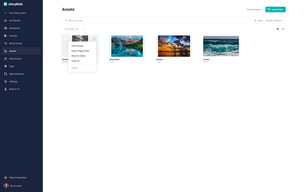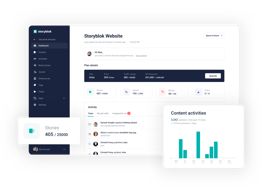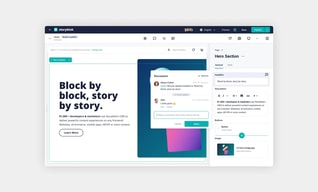

Unclaimed: Are are working at Storyblok ?
Storyblok Reviews & Product Details
Storyblok is the world's pioneer headless CMS that works for both developers & business users. Built on the premise that traditional CMS makes it difficult to repurpose content for different platforms, Storyblok offers a unique fusion of visual editing tools and highly tailored content blocks built on top of its headless architecture that provides exceptional flexibility and speed for developers.

| Capabilities |
|
|---|---|
| Segment |
|
| Deployment | Cloud / SaaS / Web-Based |
| Support | 24/7 (Live rep), Chat, Email/Help Desk, FAQs/Forum, Knowledge Base, Phone Support |
| Training | Documentation |
| Languages | English |





Compare Storyblok with other popular tools in the same category.

Among Storyblok's best features are its visual editor, spaces, stories, folder organization system, and workflow setup. It also has active customer support and a large developer community. The documentation is also very well written to cater to developer and non-developer needs.
The only downside is the unavailability of mutate/write access on its GraphQL API and a slightly steep learning curve in understanding the platform and configuring things like SSL for live preview and other integration.
Storyblok provides a central hub to manage my content, allowing me to define roles that provide certain levels of access to content and also define a creation-to-publishing workflow. It also simplifies the task of content management with its component blocks, and visual editor.
Great preview feature that makes a difference comparing to other CMS platforms.
Minor bugs. I can live with them as they not break the overall experience.
When we were looking for a headless CMS solutions, there was nothing to compare with Storyblok reagarding flexibility, ease of use and the amazing preview feature that makes the introduction of new content much easier.
Block componentes definition and console simplicity
Pricing is to high for workspace........
Content administraton flexibility
Easy to understand and smooth. Barerly needed an introduction.
Nothing really. Every feature i need is there and the integration was easy.
Easy and smooth updates of our webpage. Easy to maintain a good design.
Storyblok is a fantastic CMS for Marketing and Content teams. The user interface is clean, very easy to use, and very intuitive. As a Product Designer myself, this is something I particularly appreciate. At the studio, we are big fans of the visual editor as it allows you to see the changes you’re doing in real time. This makes it very easy to build a page, adjust content, visuals, and components to get the exact results you need.
If you want to build something new on a page that hasn’t been developed (like a new block), you will need additional development support from a frontend developer. On the other hand, this means you are not restricted by any grid or pre-build layout, as you would find in other “web-builder” tool. You can go very custom when designing and developing something.
Storyblok provides a simple solution for our clients, usually non-technical users, such as content writers or digital marketing manager, who needs to build and maintain web pages. Again, the visual editor makes it effortless for them to review the page and see what it would look like exactly when published live.
It's a great CMS, easy to use. Very productive. Great free version, which is actually useable :)
Don't now any. Maybe a simulationius preview of different breakpoints at once?
Seperating content and development
The single screen view of all of the tools a content editor would need makes life so much easier. The preview allows editors to make good design choices but still allows devs to put constraints around those choices.
It is a struggle to find anything I don't like about Storyblok v2. If I was to be picky, I would say the focus tool on the images could do with a preview showing different ratios. Something similar to https://jonom.github.io/jquery-focuspoint/demos/helper/index.html.
Trying to find a way to rapidly publish content has become easier with Storyblok v2 and Gatsby Cloud Hosting. As I have a static site, publishing content is fast, almost instantaneous.
It is indeed effortless to use due to the available components. It is also very easy to learn or to teach it to teams who have no prior knowledge about design.
The version two of Storyblok had some issues which are now being fixed. Other than that I am content.
Instead of paying an agency to help us with the website we can train people with no prior knowledge in web design in just a few days. We are saving money.
The preview feature is by far the platform's most impressive and helpful facet. But just as helpful are the drag-and-sort block reorganization, as well as the copy and paste features. We've reduced content population and new page creation by approximately 75% with these tools alone.
One downside is that it's not open source. So if our team wants to suggest a feature enhancement, we have to work through Storyblok's support, as opposed to just developing it ourselves.
A headless CMS that works with modern web frameworks and makes it easy for Marketing to own content. This allows us to develop highly optimized and secure websites for our clients, and makes it simple for our clients to manage the content themselves.
Storyblok is an awesome headless cms for any headless frontend. I love to use it for my personal projects build on Nuxt.js. I also plan to sell storyblok projects to customers in the future!
I took me a while to get into it but since i figured out the basic functionalities i am having a total blast!
It is hosted at storyblok and the community plan is one of the best i have ever seen. It is fast, easy to use and easy to develop on. Also the media library is highly benefitial.





